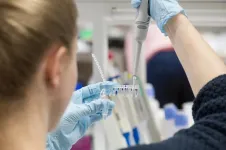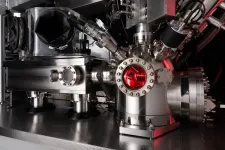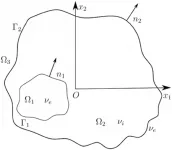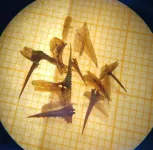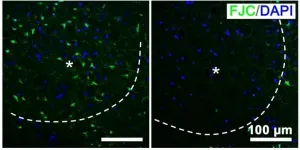(Press-News.org) Researchers at the University of Eastern Finland have found a potential neuroprotective effect of a protein modification that could be a therapeutic target in early Alzheimer's disease. The new study investigated the role of MECP2, a regulator of gene expression, in Alzheimer's disease related processes in brain cells. The study found that phosphorylation of MECP2 protein at a specific amino acid decreases in the brain as Alzheimer's disease is progressing. Abolishing this phosphorylation of MECP2 in cultured mouse neurons upon inflammatory stimulation enhanced their viability and increased the expression of important genes in the maintenance and protection of neurons. The results obtained in the study call attention to modifications of MECP2 as potential targets for developing specific therapies against AD and other neurodegenerative diseases. The study was recently published in the Cells journal.
Alzheimer's disease is the most common form of dementia with more than 40 million people living with the disease worldwide. No therapies currently exist for the effective prevention or treatment of the disease. Long before severe symptoms of Alzheimer's disease, such as memory loss and confusion occur, connections between neurons are lost and neurons are dying in the brain. Neurons are not the only cell type that contributes to Alzheimer's disease progression. Microglia, the immune cells of the brain, have been shown to contribute to neuronal damage and loss. While mildly activated microglia can protect neurons by removing harmful substances and cell debris, their chronic activation can lead to secretion of neurotoxic factors and engulfment of healthy neurons.
"The function of MECP2 phosphorylation has been almost exclusively studied in neurons. As it has become evident that microglia are involved in the pathogenesis of many neurodegenerative diseases, we chose to focus on microglial cells and co-cultures of neurons with microglia. To additionally model the activation of microglia, we induced inflammation through treatment with different compounds", says Early Stage Researcher Rebekka Wittrahm.
In post-mortem brain samples from different stages of Alzheimer's disease, this study found that phosphorylation of the MECP2 protein decreased at the amino acid serine 423 in the early stages of Alzheimer's disease. Accordingly, the question arose whether MECP2 unphosphorylated at serine 423 would change cellular processes when expressed in cultured microglia or neuron-microglia co-cultures. To study this question, both wild type MECP2 and a variant where serine 423 was mutated to prevent phosphorylation were expressed in the different cell culture models. In microglia cells, the researchers found that overexpression of wildtype MECP2 led to a decrease in phagocytic uptake of particles. Upon activation of the microglia, expression of wildtype MECP2 enhanced their inflammatory response to stimulation. For most of the analyzed parameters, blocked phosphorylation of MECP2 serine 423 did not lead to major changes as compared to the wild type protein.
In contrast to the results from microglial monocultures, the expression of the proteins in neurons co-cultured with microglia cells revealed several differences between wild type and the mutated MECP2. RNA sequencing analysis revealed that blocking of the serine 423 phosphorylation upon microglial activation increased the expression of several neuronal genes that are known to contribute to maintenance and protection of the cells.
"More extensive experiments are needed but it is conceivable that the dephosphorylation of MECP2 at serine 423 might be a mechanism of the cells to mediate neuroprotection in the early stages of Alzheimer's disease," Rebekka Wittrahm considers.
In summary, the results of this study suggest that MECP2 serine 423 is an essential phosphorylation site that might play a role in regulating neuronal gene expression upon neuroinflammation. The study calls attention to the idea that modification sites of MECP2 are potential targets for developing specific therapies against Alzheimer's disease and other neurodegenerative diseases in the future.
INFORMATION:
This study was conducted at the University of Eastern Finland, Institute of Biomedicine, in Professor Mikko Hiltunen's research group. The study was supported by the Academy of Finland, the Sigrid Jusélius Foundation and the Strategic Neuroscience Funding of the University of Eastern Finland and was part of a project co-funded by Horizon 2020 Framework Program of the European Union (Marie Sk?odowska Curie grant agreement No 740264).
For further information, please contact:
Early Stage Researcher Rebekka Wittrahm, rebekka.wittrahm (at) uef.fi
Postdoctoral Researcher Mari Takalo, tel. +358 50-3426382, mari.takalo (at) uef.fi
Professor Mikko Hiltunen, tel. +358 40-3552014, mikko.hiltunen (at) uef.fi
University of Eastern Finland, Institute of Biomedicine, Kuopio.
Research article:
Wittrahm, R.; Takalo, M.; Marttinen, M.; Kuulasmaa, T.; Mäkinen, P.; Kemppainen, S.; Martiskainen, H.; Rauramaa, T.; Pike, I.; Leinonen, V.; Natunen, T.; Haapasalo, A.; Hiltunen, M. MECP2 Increases the Pro-Inflammatory Response of Microglial Cells and Phosphorylation at Serine 423 Regulates Neuronal Gene Expression upon Neuroinflammation. Cells 2021, 10, 860. https://doi.org/10.3390/cells10040860
A study led by MedUni Vienna (Institute of Cancer Research and Comprehensive Cancer Center Vienna) sheds light on the mechanisms that lead to extremely aggressive metastasis in a particular type of pancreatic cancer, the basal subtype of ductal adenocarcinoma. The results contribute to a better understanding of the disease. The study has recently been published in the leading journal "Gut".
The most prevalent form of pancreatic cancer, Pancreatic Ductal AdenoCarcinoma (PDAC) is usually divided into two subtypes, a classical subtype and a basal subtype. The latter is highly aggressive and tends towards early metastasis. One of the distinguishing features between the two subtypes is that the classical subtype exhibits the protein GATA6. This is no longer present ...
Water in the high-mountain regions has many faces. Frozen in the ground, it is like a cement foundation that keeps slopes stable. Glacial ice and snow supply the rivers and thus the foothills with water for drinking and agriculture during the melt season. Intense downpours with flash floods and landslides, on the other hand, pose a life-threatening risk to people in the valleys. The subsoil with its ability to store water therefore plays an existential role in mountainous regions.
But how can we determine how empty or full the soil reservoir is in areas that are difficult to access? Researchers at the German Research Centre for Geosciences (GFZ), together with colleagues from Nepal, have now demonstrated an elegant method to track groundwater dynamics in high ...
The latest findings show that with clever science, a single fingerprint left at a crime scene could be used to determine whether someone has touched or ingested class A drugs.
In a paper published in Royal Society of Chemistry's Analyst journal, a team of researchers at the University of Surrey, in collaboration with the National Centre of Excellence in Mass Spectrometry Imaging at the National Physical Laboratory (NPL) and Ionoptika Ltd reveal how they have been able to identify the differences between the fingerprints of people who touched cocaine compared with those who have ingested the drug - even if the hands are not washed. The smart science behind the advance is the mass spectrometry imaging tools applied to the detection of cocaine ...
Problems for eigenmodes of a two-layered dielectric microcavity have become widespread thanks to the research of A.I. Nosich, E.I. Smotrova, S.V. Boriskina and others since the beginning of the 21st century. The KFU team first tackled this topic in 2014; undergraduates started working under the guidance of Evgeny Karchevsky, Professor of the Department of Applied Mathematics of the Institute of Computational Mathematics and Information Technology.
In this paper, the researchers discuss a model of a 2D active microcavity with a piercing hole and the possibility of a compromise between high directionality of radiation ...
The last ice age ended almost 12 000 years ago in Norway. The land rebounded slowly as the weight of the ice disappeared and the land uplift caused many bays to become narrower and form lakes.
Fish became trapped in these lakes.
Sticklebacks managed to adapt when saltwater became freshwater, and they can still be found in today's coastal lakes along the Norwegian coast.
Saltwater gradually changed to brackish water and later to freshwater. This environmental change naturally led to a total replacement of the animal and plant life.
The exception is the tiny stickleback, which successfully adapted as saltwater became freshwater and ...
A reason for these findings could be due to the fact that Parkinson's patients often also have many risk factors for a severe course of Covid-19. For the first time, the cross-sectional study provides detailed nationwide data. The research team led by Professor Lars Tönges reports in the journal Movement Disorders of 4 May 2021.
Nationwide analysis of hospital data
The team headed by Lars Tönges has analysed data on Parkinson's treatment in 1,468 hospitals. The data were taken from nationwide databases in which information on the treated diseases and of treatments carried out in hospitals is publicly collected, for example by the Institute for the Hospital Remuneration System or the Federal Statistical Office.
A comparison between the period of the first ...
Blocked blood vessels in the brains of stroke patients prevent oxygen-rich blood from getting to cells, causing severe damage. Plants and some microbes produce oxygen through photosynthesis. What if there was a way to make photosynthesis happen in the brains of patients? Now, researchers reporting in ACS' Nano Letters have done just that in cells and in mice, using blue-green algae and special nanoparticles, in a proof-of-concept demonstration.
Strokes result in the deaths of 5 million people worldwide every year, according to the World Health Organization. Millions more survive, but they often experience disabilities, such as difficulties with speech, swallowing or memory. The most common cause is a blood vessel blockage in the brain, and the best way to ...
WASHINGTON, DC (May 19, 2021) - Human genetics and genomics contributed $265 billion to the U.S. economy in 2019 and has the potential to drive significant further growth given major new areas of application, according to a new report issued today by the American Society of Human Genetics (ASHG). The findings indicate that this research and industry sector has seen its annual impact on the U.S. economy grow five-fold in the last decade and outlined at least eight areas of expanding impact for human health and society. ASHG commissioned and funded the report and is grateful for generous additional contributions from Invitae and Regeneron. ...
An international research team led by Professor Charles Gauthier from the Institut national de la recherche scientifique (INRS) has discovered a new molecule with potential to revolutionize the biosurfactant market. The team's findings have been published in Chemical Science, the Royal Society of Chemistry's flagship journal.
Surfactants are synthesized from petroleum and are the main active ingredient in most soaps, detergents, and shampoos. Biosurfactants, produced by bacteria, are safer and can replace synthetic surfactants.
Rhamnolipid molecules are some ...
Pregnant women made only modest dietary changes after being diagnosed with gestational diabetes, according to a study by researchers at the National Institutes of Health. Women with gestational diabetes are generally advised to reduce their carbohydrate intake, and the women in the study did cut their daily intake of juice and added sugars. They also increased their intake of cheese and artificially sweetened beverages. However, certain groups of women did not reduce their carbohydrate intake, including women with obesity, had more than one child, were Hispanic, had a high school degree or less, or were between the ages of 35-41 years.
The study was led by Stefanie N. Hinkle, Ph.D., of the Epidemiology Branch at NIH's Eunice Kennedy Shriver ...
